Wargames can be daunting. They tend to be more complex than most family, strategy, and thematic games, and usually come with huge rule books. Many games can take 4, 6, or even 8 or more hours to play. Not to mention that most are designed for just two players. Even if a more casual gamer was interested in trying out a historical military simulation, the barrier to entry is quite high. Therefore, the question is, can non-wargamers find anything at GMT they might want to play? I think the answer is a resounding YES!
About GMT Games
Before we get to my top 6, here is some background on the company. GMT Games was founded in 1990 by Gene Billingsley, Mike Crane, and Terry Shrum, hence the name. Headquartered in Hanford, California, GMT is known primarily as a publisher of wargames and, according to the Washington Post, is “the modern hobby’s highest-profile wargame publisher.” Indeed, their website currently lists over 500 games, expansions, and other products, making them, by far, the most prolific wargame publisher today.
GMT pioneered the pre-order system, dubbed P500, that allows customers to pre-order a title and pay for it later when it goes into production, typically when the 500-order threshold is reached. By not committing to production costs until there was a demonstrated market of at least 500 units, the P500 system allowed GMT to remain profitable at a time when other wargame publishers – most notably Avalon Hill – were struggling. Not surprisingly, other wargame publishers quickly followed suit.
GMT is probably best known for the COIN (short for counterinsurgency) series of games and Twilight Struggle. While they do simulate conflicts, they are not typical “hex and counter” wargames. Instead, they use mechanics that are familiar to Euro gamers, which helps bridge the gap between these two board game genres. However, although these are great games, I would not recommend these be your first foray into GMT because they are more complex and can take quite a long time to play.
Instead, I’m recommending games that are lower in complexity (BoardGameGeek weight rating under 3.0) and have a playing time of 3 hours or fewer once you’ve mastered the rules. All these games can be played by more than 2 players, thus making them more suitable for game night gatherings. I’ve also selected games from a variety of historical and not-so historical periods that use mechanics many non-wargamers should be familiar with. All were published recently and should be readily available for purchase.
#6 – Welcome to Centerville
Released 2017, 2-4 players, 40-80 minutes, 2.40 complexity

As you can tell by the box cover art, Welcome to Centerville is definitely not a wargame. Players take on the role of “entrepreneurs, tycoons, politicians, and other local movers and shakers” competing to manage the growth of a small city. On a player’s turn, they roll six custom dice. They have the option to accept the roll or reroll any number of dice, except those with an hourglass symbol. Players can reroll a second time, deciding again which dice to keep and which to reroll (except hourglasses). Then using the symbols on the resulting die faces they take actions on the game board. These actions – building houses, acquiring land, winning political offices, learning new vocations, etc. – will gain them Prestige or Wealth points.
Two of the dice contain an hourglass symbol. They cannot be rerolled. The player must spend each hourglass symbol to move the time marker one space on the round track. When the time marker reaches either clock tower space on the end of the round track, an end of round scoring phase is triggered. The game ends after the third scoring round. Each player’s final score is the lower of their Prestige or Wealth scores.
Described by some as Yahtzee on steroids, Welcome to Centerville is not a difficult game to learn. Simply roll the dice, reroll twice if desired, and then take the actions the final rolls allow. Each player gets a player aid sheet that provides a summary of how to use the dice, so there is no need to constantly consult the rulebook.
#5 – Talon
Released 2016, 2-6 players, 60-90 minutes, 2.52 complexity
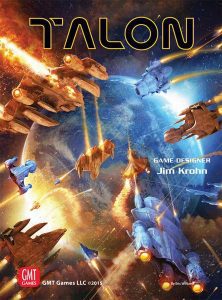
Talon is a tactical space combat game between the Terran Confederation and Talon Empire. Battles range from single ship vs. ship engagements to fleets of up to 10 ships each. The ships of the Terran Confederation and Talon Empire have unique abilities, as do the different types of ships – destroyers, cruisers, battleships, etc. – within each faction. Each ship is represented by a large laminated hexagonal counter that can be written on with a dry erase marker (2 are provided with the game). Although there are only two factions, you can play with more than two players by assigning each player one or more ships to command.
Talon uses a concept called the Power Curve to simulate how a ship’s energy is used. By adjusting the speed of the ship, you determine how much power is available to charge weapons, reinforce shields, charge batteries, and spend on other systems. It also uses an impulse-based activation system like that in Star Fleet Battles. Each turn is divided into six impulses. Your Power Curve determines in which of those impulses you can move and fire your weapons, as well as how many spaces you must move straight ahead before you can turn to the left or right. Hence, the faster you move, the less available power you will have and the less often your ship will be able to change facing (i.e., turn) each impulse.
The game comes with 54 oversized laminated ship counters that players write on with dry erase markers to indicate that ship’s Power Curve for the turn. Only the first 10 pages of the 16-page rulebook are required to play the tutorial and first scenario. There are 12 scenarios included in the separate 40-page play book, along with rules for creating your own scenarios. It even has rules on how to combine Talon with GMT’s Space Empires 4X game. There’s also an expansion, Talon 1000, that adds over 1000 scenarios and 170 new ship counters!
#4 – Apocalypse Road
Released 2020, 2-10 players, 60-90 minutes, 2.40 complexity
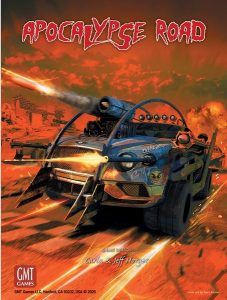
Apocalypse Road is a card-driven racing game (no pun intended) that takes place in a dystopian world reminiscent of the Mad Max movie franchise. Players are not competing as individual cars, but as part of a team of cars to gain victory points. The team that gets 12 victory points first is declared the winner. Points are awarded every time a car on your team crosses the finish line and for each enemy car you destroy. You can damage other cars through ramming, although you will suffer some damage too. Or you can use your car’s weapons – machine guns, cannons, and missiles.
Each car on your team has different capabilities. Some are faster but have less armor and therefore are easier to damage, while others have more armor by sacrificing speed. They also have different weapons and firing arcs. For example, some cars have fixed weapons that can only fire at cars to their front or to their rear. Other cars have their weapons mounted in turrets which allow them to fire in any direction. The only characteristic all cars have in common is how much damage they can take. Once any car accumulates 6 damage points, it is destroyed. But fear not. Your destroyed cars can be replaced by another in your reserve pool, assuming you have any left.
The game comes with 10 different racing teams and 2 double-sided boards each with a unique racetrack. This means there is a lot of variation from game-to-game. The rulebook is 16 pages in length, of which the actual rules comprise just 11 pages. If you enjoy Apocalypse Road, but don’t like the combat aspect, there are two other racing games in the same series, Thunder Alley and Grand Prix.
#3 – Time of Crisis: The Roman Empire in Turmoil, 235-284 AD
Released 2017, 2-4 players, 120-180 minutes, 2.97 complexity
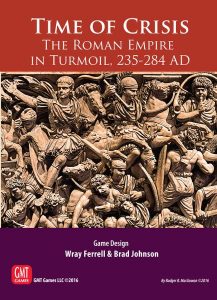
Players take on the role of competing families in Third Century Rome. Each player starts the game by controlling a single province and attempts to gain control of additional provinces, build armies, develop support among the Senate and people, defend the borders of the Empire against barbarian invasions, and battle their rivals. In doing so, they will gain legacy points. Players must also deal with random crises each turn. Bonus legacy points are awarded at the end of the game based on how many turns each player was able to remain as Emperor by controlling the province of Italia. Players can even opt to become a pretender emperor by creating their own breakaway empire from the provinces they control.
You begin the game with 9 Influence cards in your Available pile: 3 Military, 3 Senate, and 3 Populace cards. You choose any five to put into your starting hand. These starting cards each have an Influence Point value of 1. On your turn, you play the cards in your hand to use them for their Influence Point values to perform certain actions depending on the type of card. You also get to use each card for the event printed on it. After you’ve taken all your actions and performed any resulting combat, you count the number of political points generated by each province you govern to purchase additional cards from an array of higher Influence Point value cards next to the game board…a deck-building mechanic reminiscent of Dominion. Purchased cards are added to your Discard pile. At the end of your turn, you select any five cards from the Available pile to create your hand for the next turn. When your Available Pile runs out, you simply add all the cards in your Discard pile to your Available pile. So as the game progresses, you will have more cards with higher values in your hand enabling you to accomplish more actions each turn.
While a wargame, Time of Crisis uses Euro-style game mechanics, making it much more accessible to non-wargamers. There are only about 10 pages of rules in the 20-page rulebook, making this an extremely easy game to learn. The remainder of the rulebook contains an extended example of play, as well as some interesting historical notes. Although it can be played with two players, higher player counts make for a much more interesting game.
#2 – SpaceCorp: 2025-2300AD
Released 2018, 1-4 players, 60-240 minutes, 2.94 complexity

SpaceCorp is a card-driven game of space exploration and development. Each player is a corporation attempting to earn profits by expanding its influence further and further out into space. The game consists of three eras. The Mariners era covers exploration of the inner solar system out to Mars. In the Planeteers era, players extend their reach from the asteroid belt out to Pluto. Finally, in the Star Farers era, players will explore and colonize nearby star systems. A game can consist of any single era, the Mariners and Planeteers era, the Planeteers and Star Farers era, or all three eras. Over the course of the game, each corporation will attempt to be the first to fulfill contracts that will earn them profits. The player with the most profits at the end of the game is the winner.
A player takes one, and only one, action on their turn and does so by playing any number of cards from their hand. Each card will have one or two actions listed along with a point value for each. The more points you spend on an action, the more you can do with that action. Actions include:
- Moving one of your spacefaring teams from one location to another
- Exploring a location to discover resources
- Building one of several different types of bases on an explored location
- Researching to obtain additional cards
- Producing at one of your bases to earn more profits
- Upgrading your infrastructure so you can receive additional action points
- Advancing in genetics to obtain an adaptation
- Advancing in revelation to obtain technological breakthroughs
- Special actions as indicated on the card
Turns in SpaceCorp go very fast since each player can take only a single action. It also means players must plan actions several turns ahead to accomplish their goals and beat the competition to the best sites and resources. Only the first 13 pages of the 24-page main rulebook are required to play the Mariners era. The rest of the rulebook adds the rules for playing the Planeteers and Star Farers eras, as well as game variant options. A second rulebook is dedicated to the solitaire variant. GMT recently released SpaceCorp Ventures, an expansion that includes 14 asymmetric corporations, new action and contract cards, and other content.
#1 – Versailles 1919
Released 2020, 1-4 players, 60-120 minutes, 2.75 complexity
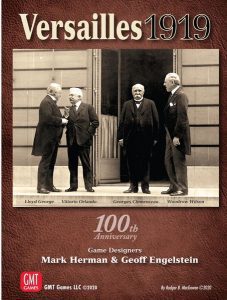
World War I ended with the November 11, 1918, armistice. But can you win the peace at the Versailles peace conference? In Versailles 1919 each player is the leader of one of the Entente (allied) powers: David Lloyd George of the United Kingdom, George Clémenceau of France, Woodrow Wilson of the United States, or Vittorio Orlando of Italy. You use your political influence and military might to settle issues regarding the fate of nations and regions throughout the globe.
Players must take one Political Action each turn: reclaim exhausted influence cubes and military tokens, bid on issues using their available influence cubes, or settle an issue. They can also take one Military Action to either deploy or demobilize one of their military tokens. When bidding influence, you must bid on exactly two issues and place enough cubes to have the most on both Issue cards. Only issues in the Conference Room can be settled. The player with the most cubes on that Issue card can put it in their area and gain Victory Points for it at the end of the game. However, you don’t have to be the player with the most cubes to settle an issue. In fact, players can make deals during the game. For example, you may agree to settle an issue in another player’s favor if they agree not to bid on another issue card. All deals are binding.
Throughout the game, new Event and Issue cards will rotate through the Waiting Room to the Conference Room, and certain events will trigger regional crises and uprisings that allow players to take settled issues from another player. Deploying military tokens can reduce the chance of a successful uprising, but at the cost of losing political influence and reducing national happiness. Following the first uprising of the game, each player selects a Strategy Card that has additional end-game scoring conditions. These cards indicate the leader’s agenda regarding the maintenance of the colonial status quo, supporting aspirations for self-determination, payment of German reparations, containment of future German aggression, territorial concessions, dealing with the threat of Bolshevism, and whether to sign on to the League of Nations. The player who accumulates the most Victory Points via controlled issues, national happiness, and meeting their strategy card conditions wins.
Although Versailles 1919 is based on historical events immediately after the Great War, it is not a wargame. Instead, the conflict between players is primarily political as each victorious power attempts to cement its position in the post-war world. The mechanisms it uses are novel, but not difficult to learn. While it certainly can be played solo and with two players, it really shines as a 3 to 4 player game. GMT has two other games in their Great Statesmen series, Churchill and Pericles, with two others on their P500 list.
So there you have my choice for the top six GMT games for non-wargamers. All of these games are eminently accessible to casual boardgamers due to their lower complexity and use of mechanics found in other board game genres. Although Talon and Time of Crisis are indeed wargames, they are not anything like traditional hex and counter wargames. So don’t worry if you’re not a grognard. They’re on the list because they are not only good games, but also because they can be easily learned. And while there is battle of sorts in Apocalypse Road and certainly political conflict in Versailles 1919, neither are wargames. Finally, Welcome to Centerville and SpaceCorp involve economic competition, rather than warfare. Hopefully, this variety will suit the different tastes of our readers and help serve as an entryway into all the amazing games GMT has to offer.


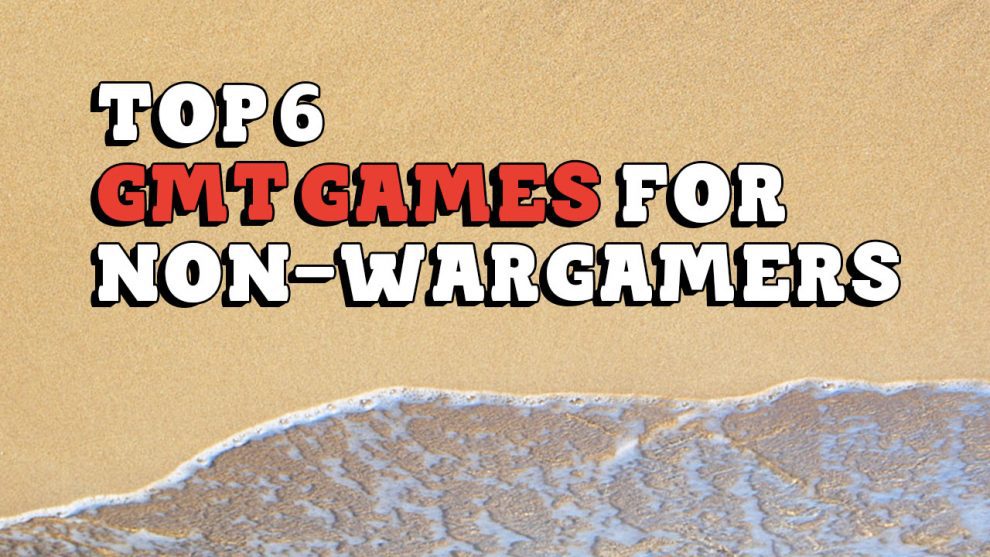






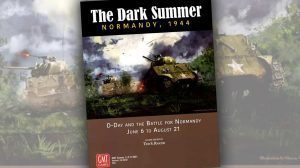







Add Comment